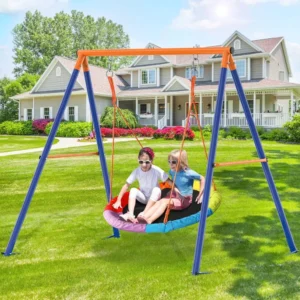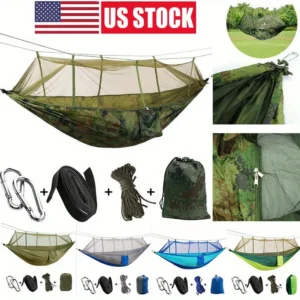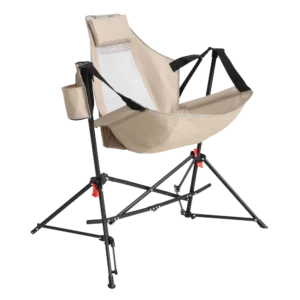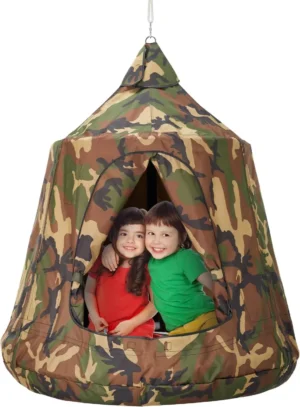Why Efficient Packing of Your Hammock is Crucial
For outdoor enthusiasts, how you pack your hammock can make a significant difference in your overall experience. Whether you’re a weekend warrior or a seasoned backpacker, mastering efficient hammock packing techniques offers three major benefits:
- Space optimization: A poorly packed hammock can take up to 30% more space in your backpack than necessary, limiting room for other essential gear
- Time efficiency: Well-practiced packing methods can reduce your setup and takedown time by several minutes, giving you more time to enjoy the outdoors
- Equipment protection: Proper packing extends the life of your hammock by preventing unnecessary strain on fabrics and components
This guide is designed for anyone who uses a hammock in the outdoors—from casual day-trippers to ultralight backpackers and long-distance hikers. We’ll cover various packing approaches, from traditional stuff sack methods to more specialized techniques like snake skins.
Understanding advanced ultralight hammock packing techniques can significantly reduce your overall pack weight and volume, making your outdoor adventures more enjoyable and less physically demanding.
Basics: Understanding Hammock Types and Their Accessories
Hammock Anatomy Basics
Before diving into packing techniques, it’s helpful to understand the basic components of a hammock system:
- Hammock body: The main fabric portion where you lie down
- Suspension points: The ends of the hammock where suspension systems attach
- Ridgeline: An optional cord running above the hammock that maintains optimal sag
Common Accessories
Most hammock setups include several components beyond just the hammock itself:
- Suspension systems: Straps, whoopie slings, or ropes that attach to trees
- Tarps (rain flies): Protection from rain and elements
- Bug nets: Mesh coverings to keep insects away
- Insulation: Underquilts and topquilts that provide warmth
Material Considerations
Different hammock materials affect how they pack:
- Ultralight hammocks (typically 7 oz or 200g) made from 1.0 oz/yard nylon compress smaller than standard hammocks (16 oz or 450g) made from heavier 210T nylon or 70D polyester
- Silnylon tarps pack smaller than polyester or cotton canvas tarps
- Lightweight suspension systems take up less space than traditional rope systems
Understanding your specific gear is the first step toward efficient packing. Many ultralight camping hammock sets are designed with packing efficiency in mind, using materials that compress well while maintaining durability. For those looking to minimize weight without sacrificing comfort, exploring the ultimate guide to ultralight hammocks can provide valuable insights.
The Stuff Sack Method: Classic and Proven
The stuff sack method remains the most common way to pack a hammock. It’s straightforward, effective, and works with virtually any hammock design.
Step-by-Step Instructions:
- Lay out your hammock flat on a clean surface
- Gather the fabric from one end, working toward the center
- Continue gathering from the opposite end until you have a long bundle
- Fold the bundle in half if necessary to match your stuff sack size
- Insert into the stuff sack bottom-first (suspension end last)
- Push out excess air as you pack to minimize volume
- Close the stuff sack securely
Advantages and Limitations:
Pros:
– Universal compatibility with all hammock types
– Protects hammock from dirt and moisture
– Compression sacks can reduce volume by up to 50%
Cons:
– Takes longer than some specialized methods
– Potential for tangling suspension components
– Requires repacking the entire system for setup
Pro Tips:
- Store suspension components in a separate small pocket in your stuff sack
- Use compression straps to further reduce packed size
- Consider waterproof or water-resistant stuff sacks for added protection
Many camping hammocks with stands come with appropriately sized stuff sacks designed specifically for efficient packing. Quality compression sacks allow you to reduce the packed volume significantly, making this traditional method still highly relevant for modern hammock camping.
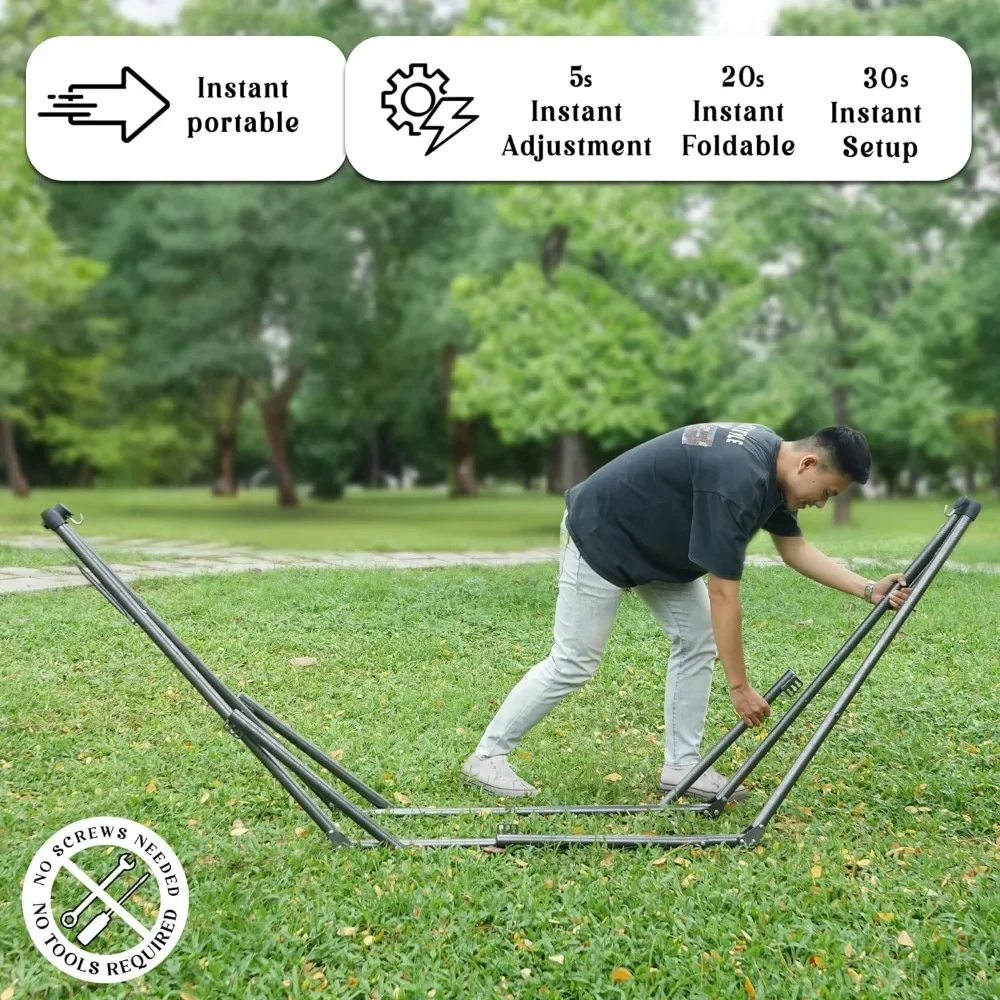
The Snake Skin Technique: Quick and Clean
Snake skins represent a more advanced approach to hammock packing that prioritizes speed and convenience over absolute minimum packed size.
What Are Snake Skins?
Snake skins are tubular sleeves that slide over your hammock from both ends, allowing you to pack it without removing it from the trees. They’re typically made of lightweight, water-resistant materials like silnylon or ripstop polyester.
Step-by-Step Guide:
- Install snake skins on your hammock before initial setup (one at each end)
- Push each skin back to expose the hammock for setup
- When packing up, slide one snake skin down toward the center of the hammock
- Slide the other skin from the opposite end until they meet in the middle
- Detach the suspension system from the trees
- Bundle the suspension and secure with included straps or velcro
Key Advantages:
- Time savings: Reduces pack-up time from 4-5 minutes to under 1 minute
- Cleanliness: Keeps your hammock clean since it never touches the ground
- Convenience: Allows for quick setup and takedown without complete repacking
- System integration: Can keep tarps and bug nets attached in some configurations
Potential Drawbacks:
- Slightly bulkier packed size compared to stuff sack method
- Initial investment in specialized equipment
- Learning curve for optimal usage
DIY Options:
You can create your own snake skins using:
– Water-resistant ripstop nylon
– Silicon-coated tent floor material
– Lightweight shower curtains or similar materials
For those who frequently set up and take down their hammocks, mastering how to efficiently pack your hammock with snake skins can save significant time on the trail, especially during multi-day adventures.
Folding and Rolling: Alternative Approaches for Specific Situations
When specialized packing equipment isn’t available or when space configuration matters more than absolute minimum size, folding and rolling techniques offer practical alternatives.
The Basic Fold Method:
- Lay hammock flat on a clean surface
- Fold in half lengthwise once or twice to create a narrow strip
- Fold in thirds from one end toward the center
- Fold again from the opposite end
- Secure with a strap or place in a storage bag
The Precision Roll Technique:
- Lay hammock flat and smooth out any wrinkles
- Align suspension components along the edges
- Begin rolling tightly from one end, keeping tension consistent
- Compress the roll as you progress
- Secure with straps or cord when complete
When These Methods Work Best:
- Home storage: When protection from the elements isn’t a concern
- Car camping: When space configuration matters more than absolute minimum size
- Quick deployment: When you’ll be setting up again soon
- Rectangular tarps: Often pack better folded than stuffed
Combining Methods:
Many experienced hammockers develop hybrid approaches:
– Fold suspension components separately from the hammock body
– Roll the hammock but stuff accessories
– Use folding for dry components and stuff sacks for potentially wet items
Effective lightweight hammock gear organization often involves using different packing methods for different components of your hammock system, allowing you to optimize both space efficiency and access to frequently needed items.
Efficiently Packing Accessories: Suspension System, Tarp, and More
A complete hammock setup involves more than just the hammock itself. Here’s how to efficiently pack each component:
Suspension Systems:
- Daisy chain straps: Fold accordion-style, securing with the built-in loop
- Whoopie slings: Coil in a figure-eight pattern to prevent tangling
- Carabiners/hardware: Store in small pouches to prevent damaging other gear
- Ropes: Use the butterfly coil method to prevent twisting and knots
Tarp Packing:
- Rectangle tarps: Fold using the map-fold technique (in thirds both directions)
- Diamond/hex tarps: Fold to center from all sides, then fold in half twice
- Wet tarps: Roll rather than fold to isolate moisture
- With guy lines: Wrap guy lines around folded tarp rather than bundling separately
Bug Net Approaches:
- Stuff nets separately from the hammock to prevent snags
- For integrated bug net systems, pack with the net on the inside of the fold/roll
- Use small stuff sacks to keep nets isolated from other gear
Insulation Packing:
- Compression sacks are essential for underquilts and topquilts
- Pack insulation separately from potentially wet components
- Consider vacuum storage bags for extreme compression
Purchasing complete camping hammock systems often means you get components designed to work together when packed, with properly sized storage solutions for each element. This systematic approach helps maintain organization while minimizing overall pack volume.
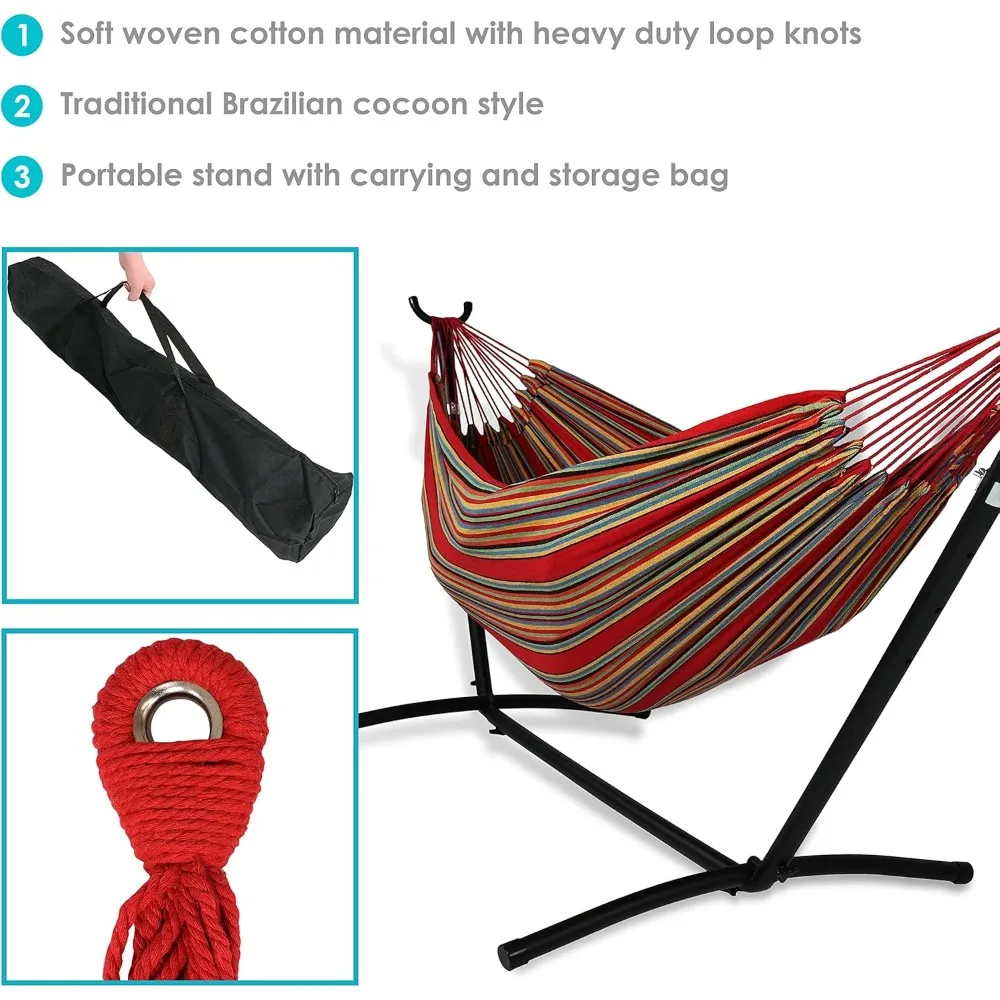
Backpack Integration: Strategic Placement
How you organize your packed hammock components within your backpack can significantly impact comfort and convenience on the trail.
Weight Distribution Principles:
- Place heavy items (like water and food) closest to your back and centered
- Position the hammock in the middle or top section of your pack for quick access
- Keep tarp accessible in external pockets or at the top of your pack in wet conditions
- Distribute suspension components to maintain balance
Accessibility Considerations:
- What will you need first at camp? Pack these items last
- In rainy regions, ensure your tarp is immediately accessible
- Consider separating day-use items from camp-only equipment
Modular vs. Integrated Packing:
- Modular approach: Each component in its own container, offering flexibility but potentially more bulk
- Integrated approach: Multiple components packed together, saving space but requiring complete unpacking for setup
Specialized Backpack Features:
- External compression straps can secure hammock components
- Side pockets work well for suspension systems
- Mesh outer pockets are ideal for quick-drying wet tarps
- Bottom compartments can isolate sleeping gear
For those focused on minimalist setups, exploring backpacking with compact hammocks provides additional insights on how to integrate hammock systems into smaller packs while maintaining quick access to essential components.
Pro Tips for Maximum Efficiency and Equipment Protection
Elevate your hammock packing game with these expert techniques that apply regardless of your primary packing method:
• Always dry your hammock before long-term storage to prevent mildew and fabric degradation
• Protect suspension endpoints by tucking them inside the packed hammock or using dedicated hardware pouches
• Use small silicone bands to keep cords and guy lines organized and tangle-free
• Practice your chosen packing method at home before relying on it in the field
• Lay out a small ground cloth during the packing process to keep gear clean and dry
• Pack components in a consistent order to develop muscle memory and ensure nothing is forgotten
• Use color-coding or labeled stuff sacks to quickly identify components in low light
• Remove unnecessary packaging or tags to reduce bulk and weight
• Keep frequently used items (like tree straps) in dedicated external pockets
• Isolate any metal hardware to prevent abrasion damage to fabric components
Many camping hammock sets with bug nets require special consideration during packing to prevent mesh damage. Storing bug nets inside out or in separate compartments can prevent snags and tears that would compromise their effectiveness.
Comparing Packing Methods: Which is Right for You?
| Method | Packed Size | Speed | Protection | Cost | Complexity |
|---|---|---|---|---|---|
| Stuff Sack | ★★★★☆ | ★★☆☆☆ | ★★★★☆ | $ | Beginner |
| Snake Skins | ★★★☆☆ | ★★★★★ | ★★★★☆ | $$ | Intermediate |
| Roll Method | ★★☆☆☆ | ★★★☆☆ | ★★☆☆☆ | Free | Beginner |
| Fold Method | ★★★☆☆ | ★★★☆☆ | ★★☆☆☆ | Free | Beginner |
Best Methods By User Type:
Ultralight Backpackers:
Compression stuff sacks offer the smallest packed size, though snake skins may be worth the slight volume increase due to their speed advantages on multi-day trips.
Weekend Warriors:
Snake skins provide the best balance of convenience and protection, making them ideal for those who set up and take down camp frequently.
Casual Users:
The basic fold or roll methods work well for occasional hammockers who aren’t as concerned with absolute minimum pack size.
Winter Campers:
Stuff sacks offer the best protection from environmental moisture, which is crucial when camping in snow or wet conditions.
Mixing Methods:
Many experienced hammockers develop hybrid approaches:
– Using snake skins for the hammock but stuff sacks for the tarp
– Employing the roll method for home storage but switching to stuff sacks for backpacking
– Keeping suspension in dedicated organizers while using different methods for the hammock body
The lightweight hammock sets offered by Outside Luxe are designed to be compatible with multiple packing methods, allowing you to adapt your approach based on your specific trip needs.
Integrated System vs. Separate Components: Packing According to Your Setup
Your hammock system configuration dramatically influences your optimal packing approach.
All-in-One Systems:
Integrated hammock systems combine the hammock, bug net, and sometimes even the tarp into a single unit.
Advantages:
– Single-step setup and takedown
– Fewer individual components to manage
– Often lighter overall weight
– Simplified packing process
Packing Considerations:
– Typically require a larger single stuff sack
– Less flexibility for separating wet components
– Usually work well with snake skin systems
Modular Component Systems:
These systems use separate, interchangeable parts that can be mixed and matched.
Advantages:
– Ability to bring only what’s needed for specific trips
– Can separate wet components from dry
– Easier replacement of individual damaged parts
– More versatility for different conditions
Packing Considerations:
– Requires multiple stuff sacks or organizers
– More complex to pack efficiently
– Can distribute weight more evenly in a backpack
Hybrid Approaches:
Many modern hammock systems fall somewhere in between, with partially integrated components like built-in bug nets but separate tarps and suspension.
While some hammock maintenance concerns are universal, understanding whether it’s okay to leave a hammock outside can help inform both your packing strategy and your overall hammock care routine.
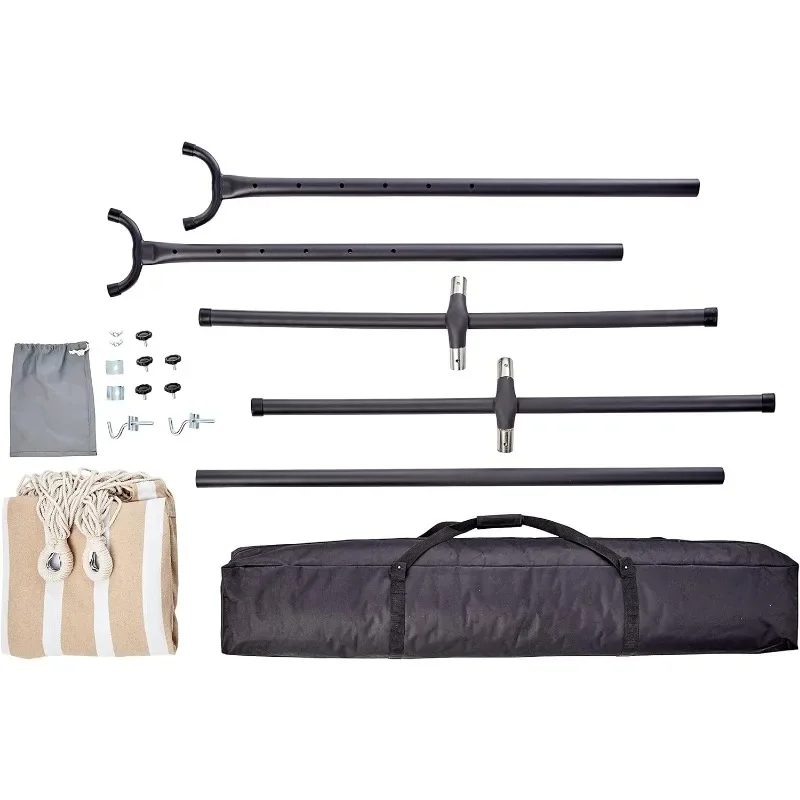
Common Hammock Packing Mistakes and How to Avoid Them
Problem: Packing a Damp Hammock
Solution: Always allow your hammock to air dry completely before long-term packing, or at minimum, separate damp items from dry ones and repack after drying.
Problem: Tangled Suspension Systems
Solution: Store straps, whoopie slings, and other suspension components in dedicated pouches or use butterfly coils secured with velcro straps.
Problem: Stuffing Too Forcefully
Solution: Use gentle compression rather than forceful stuffing to avoid stressing fabric and seams. Take your time to evenly distribute the material.
Problem: Forgetting Components
Solution: Develop a consistent packing checklist and always pack items in the same order and location to ensure nothing is left behind.
Problem: Improper Bug Net Storage
Solution: Pack bug nets inside out or in separate compartments to prevent snags on other equipment.
Problem: Disorganized Guy Lines
Solution: Wrap guy lines around your hand in a figure-eight pattern before securing, or use dedicated line organizers to prevent tangling.
Problem: Mixing Clean and Dirty Components
Solution: Use a small ground cloth during setup and takedown to keep components clean, and consider separate storage for items that touch the ground.
For those who frequently deal with highly compressed gear, understanding proper hammock compression techniques can prevent equipment damage while still achieving minimum packed size.
Packing for Different Situations: From Day Hikes to Expeditions
Your packing approach should adapt to match your specific adventure needs:
Day Hikes:
- Focus on quick deployment and repacking
- Consider leaving some components at home (like bug nets in dry, bug-free seasons)
- Prioritize accessibility over absolute minimum size
- Snake skins excel for quick setup and takedown
Weekend Trips:
- Balance space efficiency with convenience
- Separate potentially wet items from items that must stay dry
- Pack based on the expected setup/takedown frequency
- Consider weather forecast when choosing packing methods
Extended Expeditions:
- Maximize compression for long-haul comfort
- Use waterproof stuff sacks for critical components
- Develop systems for managing partially wet equipment over multiple days
- Include repair materials for packing components (extra stuff sacks, cord, etc.)
Weather Considerations:
- In rainy conditions, keep your tarp most accessible
- For humid environments, allow for ventilation in packed items when possible
- In dusty areas, prioritize sealed storage solutions
Portable hammocks with stands offer unique packing challenges but provide flexibility for camping in areas without suitable trees, making them worth considering for certain trip types despite their additional packed weight and volume.
Camping Hammock Sets with Bug Net, Ultralight Camping Hammock Sets
$139.72 Select options This product has multiple variants. The options may be chosen on the product pageFolding Hammock Sets, Quick Setup Hammock Sets
Price range: $305.52 through $583.27 Select options This product has multiple variants. The options may be chosen on the product pageCamping Hammock Sets with Bug Net, Complete Camping Hammock Systems
Price range: $82.73 through $97.96 Select options This product has multiple variants. The options may be chosen on the product pageFolding Hammock Sets, Lightweight Hammock Sets
$295.80 Select options This product has multiple variants. The options may be chosen on the product pageComplete Camping Hammock Systems, Hanging Egg Chair Sets
$266.73 Select options This product has multiple variants. The options may be chosen on the product page
Innovative Products and Solutions for Efficient Hammock Packing
The market offers specialized products designed specifically to enhance hammock packing efficiency:
Advanced Compression Systems
Ultra-compression stuff sacks use directional compression straps that can reduce packed volume by up to 60% compared to standard stuff sacks. These typically feature air-purging valves and multi-directional compression straps.
Key Features:
– Weather-resistant materials
– Roll-top closures
– Multiple compression straps
– Typical price range: $20-35
Premium Snake Skins
High-end snake skins go beyond basic tubes with features like integrated suspension storage, water-resistant coatings, and ultralight materials.
Key Features:
– Silicone-treated ripstop nylon construction
– Reinforced openings to prevent tearing
– Color-coding for easy orientation
– Typical price range: $15-25 for standard sets
DIY Alternatives
Many hammock enthusiasts create their own packing solutions:
– Repurposed tent pole bags make excellent snake skins
– Balloon stuff technique using plastic bags as temporary compression aids
– Modified compression sacks with added straps and compartments
Multi-Component Organizers
These systems feature multiple connected pouches designed to keep hammock components organized while maintaining a compact overall package.
For those prioritizing quick setup and takedown, quick-setup hammock sets incorporate design features specifically for efficient packing and deployment, often including specialized storage solutions.
Weather Protection: Packing for Rain and Moisture
Dealing with wet conditions requires specialized packing approaches to protect your gear and comfort:
Packing Wet Equipment:
- Separate wet components from dry ones using waterproof barriers
- Position wet items on the outside of your pack when possible
- Use dedicated wet storage bags with moisture barriers
- Remember that rolled wet tarps generally shed water better than stuffed ones
Moisture Management Techniques:
- Quick-dry microfiber cloths can remove excess moisture before packing
- Silicone-treated stuff sacks repel external moisture
- Consider vapor barriers between wet and dry components
- Air out equipment during breaks when possible
Separation Strategies:
- Use different colored stuff sacks for wet vs. dry components
- Pack wet tarps in exterior mesh pockets for continued drying
- Keep critical items (like insulation) in waterproof compression sacks regardless of conditions
- Consider double-bagging especially important dry items in wet environments
Quick-Access Rain Protection:
- Pack tarps last and on top for immediate access when rain threatens
- Keep a small packable tarp accessible for quick deployment during sudden storms
- Consider pre-rigged guy lines to speed setup in rainy conditions
By applying these efficient packing techniques to your hammock system, you’ll save space, time, and frustration on your outdoor adventures. Whether you’re a weekend warrior or preparing for a thru-hike, mastering these methods will enhance your hammocking experience and leave more room in your pack for other essentials.



